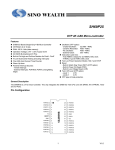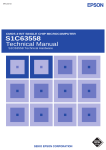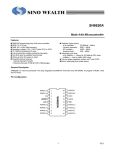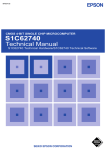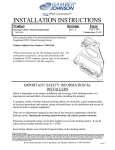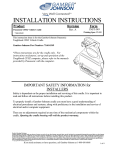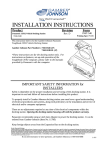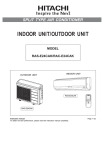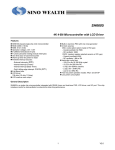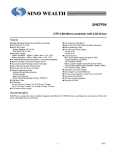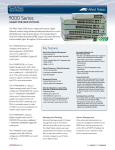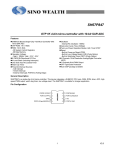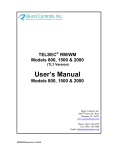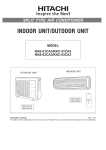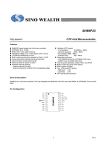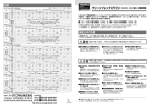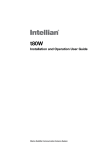Download SH67P33
Transcript
SH67P33 OTP 4-bit Micro-controller Features SH6610C-based single-chip 4-bit micro-controller ROM: 1K X 16 bits OTP ROM RAM: 48 X 4 bits RAM (Data Memory) Operation voltage: 1.8V - 3.6V (Typical: 3.0V) 16 CMOS bi-directional I/O pins and 1 COMS input pin 4-level subroutine nesting (including interrupts) One 8-bit auto re-loadable timer/counter Warm-up timer for power-on reset Powerful interrupt sources: - Internal interrupt (Timer0). - External interrupts: (rising edge). PORTB & PORTC or PORTB, PORTC & PORTD (Code Option) Remote control programmable carrier synthesizer Oscillator :(Code Option) - External Ceramic Resonator/Crystal Oscillator: 400kHz - 4MHz - Built-in RC Oscillator: 4MHz typical Instruction cycle time: - 4/455kHz (≈ 8.79µs) for 455kHz OSC clock - 4/4MHz (= 1µs) for 4MHz OSC clock Two low power operation modes: HALT and STOP Built-in watchdog timer OTP type/Code protection 20-pin DIP/TSSOP/SOP package General Description SH67P33 is dedicated to infrared remote control transmitter applications. This chip integrates the SH6610C 4-bit CPU core with RAM, program ROM, one 8-bit timer, and programmable input/output pins and carrier synthesizer. When in standby function, system will stop oscillator and remain low power dissipation. Pin Configuration 1 20 VDD PORTD.0 2 19 REM PORTD.1 3 18 PORTA.3 PORTE.0/OSCI 4 17 PORTA.2 PORTE.1/OSCO 5 16 PORTA.1 PORTD.2 6 15 PORTA.0 PORTC.0 7 14 PORTB.3 PORTC.1 8 13 PORTB.2 PORTC.2 9 12 PORTB.1 PORTC.3 10 11 PORTB.0 SH67P33 GND 1 V2.0 SH67P33 Block Diagram OSCI LOW VOLTAGE RESET WATCHDOG OSCO OSC CPU PORTA (4 BITS) PRESCALER PORTA [0:3] PORTB (4 BITS) PORTB [0:3] PORTC (4 BITS) PORTC [0:3] PORTD (3 BITS) 8-BIT TIMER (UP COUNTER) CTL REG. PORTD [0:2] PORTE (2 BITS) TIMER INTERRUPT ROM 1K X 16BIT PORTE [0:1] REMOTE CONTROL SYNTHESIZER DATA RAM 48 X 4 BIT REM 2 SH67P33 Pin Descriptions Pin No. Designation I/O Description 7 - 10 PORTC [0:3] I/O 2 PORTD.0 I 3, 6 PORTD [1:2] I/O Bit programmable I/O pins 19 REM O Carrier synthesizer for infrared or RF output pin 20 VDD P Power supply 4 PORTE.0/OSCI I/O Bit programmable I/O pin, shared with oscillator input pin connected to ceramic resonator or crystal oscillator 5 PORTE.1/OSCO I/O Bit programmable I/O pin, shared with oscillator output pin connected to ceramic resonator or crystal oscillator 1 GND P 15 - 18 PORTA [0:3] I/O Bit programmable I/O pins 11 - 14 PORTB [0:3] I/O Bit programmable I/O pins, Vector Interrupt (Active rising edge) Bit programmable I/O pins, Vector Interrupt (Active rising edge) Input pin Ground pin OTP Programming Pin Description (OTP Program Mode) Pin No. Designation I/O Shared by 20 VDD P VDD 2 VPP P PORTD.0 1 GND P GND 4 SCK I PORTE.0/OSCI 15 SDA I/O PORTA.0 Description Programming Power supply (+5.5V) Programming high voltage Power supply (+11.0V) Ground Programming Clock input pin Programming Data pin 3 SH67P33 Functional Description 1. CPU The CPU contains the following functional blocks: Program Counter (PC), Arithmetic Logic Unit (ALU), Carry Flag (CY), Accumulator, Table Branch Register, Data Pointer (INX, DPH, DPM, and DPL) and Stacks. 1.1. PC The PC is used for ROM addressing consisting of 12-bits: Page Register (PC11), and Ripple Carry Counter (PC10, PC9, PC8, PC7, PC6, PC5, PC4, PC3, PC2, PC1, PC0). The program counter is loaded with data corresponding to each instruction. The unconditional jump instruction (JMP) can be set at 1-bit page register for higher than 2K. The program counter cans only 4K program ROM address. (Refer to the ROM description). 1.2. ALU and CY The ALU performs arithmetic and logic operations. The ALU provides the following functions: Binary addition/subtraction (ADC, SBC, ADD, SUB, ADI, SBI) Decimal adjustments for addition/subtraction (DAA, DAS) Logic operations (AND, EOR, OR, ANDIM, EORIM, ORIM) Decisions (BA0, BA1, BA2, BA3, BAZ, BNZ, BC, BNC) Logic Shift (SHR) The Carry Flag (CY) holds the ALU overflow that the arithmetic operation generates. During an interrupt service or CALL instruction, the carry flag is pushed into the stack and recovered from the stack by the RTNI instruction. It is unaffected by the RTNW instruction. 1.3. Accumulator (AC) The accumulator is a 4-bit register holding the results of the arithmetic logic unit. In conjunction with the ALU, data is transferred between the accumulator and system register, or data memory can be performed. 1.4. Table Branch Register (TBR) Table Data can be stored in program memory and can be referenced by using Table Branch (TJMP) and Return Constant (RTNW) instructions. The TBR and AC are placed by an offset address in program ROM. TJMP instruction branch into address ((PC11 - PC8) X (28) + (TBR, AC)). The address is determined by RTNW to return look-up value into (TBR, AC). ROM code bit7-bit4 is placed into TBR and bit3-bit0 into AC. 1.5. Data Pointer The Data Pointer can indirectly address data memory. Pointer address is located in register DPH (3-bits), DPM (3-bits) and DPL (4-bits). The addressing range can have 3FFH locations. Pseudo index address (INX) is used to read or write Data memory, then RAM address bit9 - bit0 comes from DPH, DPM and DPL. 1.6. Stack The stack is a group of registers used to save the contents of CY & PC (11-0) sequentially with each subroutine call or interrupt. The MSB is saved for CY and it is organized into 13 bits X 4 levels. The stack is operated on a first-in, last-out basis and returned sequentially to the PC with the return instructions (RTNI/RTNW). Note: The stack nesting includes both subroutine calls and interrupts requests. The maximum allowed for subroutine calls and interrupts are 4 levels. If the number of calls and interrupt requests exceeds 4, then the bottom of stack will be shifted out, that program execution may enter an abnormal state. 2. ROM The ROM can address 1K X 16 bits of program area from $000 to $3FF. 2.1. Vector Address Area ($000 to $004) The program is sequentially executed. There is an area address $000 through $004 that is reserved for a special interrupt service routine such as starting vector address. Address Instruction Remarks $000 JMP instruction Jump to RESET service routine $001 NOP Reserved $002 JMP instruction Jump to TIMER0 interrupt service routine $003 NOP Reserved $004 JMP instruction Jump to PORT interrupt service routine * JMP instruction can be replaced by any instruction. 4 SH67P33 3. RAM Built-in RAM contains of general-purpose data memory and system register. Because of its static nature, the RAM can keep data after the CPU enters STOP or HALT. 3.1. RAM Addressing Data memory and system register can be accessed in one instruction by direct addressing. The following is the memory allocation map: System register and I/O: $00 - $1F Data memory: $020 - $04F 3.2. Configuration of System Register: System Register $00-$1F RAM Map: Address Bit3 Bit2 Bit1 $00 $01 Bit0 R/W - IET0 - IRQT0 $02 - $03 - Remarks - IEP R/W Interrupt enable flags - IRQP R/W Interrupt request flags TM0.2 TM0.1 TM0.0 R/W Timer0 Mode register (Prescaler) - - - - Reserved $04 TL0.3 TL0.2 TL0.1 TL0.0 R/W Timer0 load/counter register low nibble $05 TH0.3 TH0.2 TH0.1 TH0.0 R/W Timer0 load/counter register high nibble $06 - $07 - - - - - $08 PA.3 PA.2 PA.1 PA.0 R/W PORTA Reserved $09 PB.3 PB.2 PB.1 PB.0 R/W PORTB $0A PC.3 PC.2 PC.1 PC.0 R/W PORTC $0B - PD.2 PD.1 PD.0 R/W PORTD $0C - - PE.1 $0D - - - $0E TBR.3 TBR.2 TBR.1 PE.0 REMO REM TBR.0 R/W W R R/W PORTE Bit0: REMO output data Bit0: REM pin output status Table Branch Register $0F INX.3 INX.2 INX.1 INX.0 R/W Pseudo index register $10 DPL.3 DPL.2 DPL.1 DPL.0 R/W Data pointer for INX low nibble $11 - DPM.2 DPM.1 DPM.0 R/W Data pointer for INX middle nibble $12 - DPH.2 DPH.1 DPH.0 R/W $13 PPULL CPS2 CPS1 CPS0 R/W $14 WDT - - - R/W $15 LVR3 LVR2 LVR1 LVR0 R/W $16 PACR.3 PACR.2 PACR.1 PACR.0 R/W Data pointer for INX high nibble Bit2-0: Carrier count source pre-divider Bit3: Port Pull-low MOS Control Bit3: Watchdog timer reset/flag (Write 1 to reset WDT timer) LVR Enable Control (LVR3 - 0): 1010: LVR Disable Else: LVR Enable (Power-on initial 0000) PORTA input/output control $17 PBCR.3 PBCR.2 PBCR.1 PBCR.0 R/W PORTB input/output control $18 PCCR.3 PCCR.2 PCCR.1 PCCR.0 R/W PORTC input/output control $19 - PDCR.2 PDCR.1 0 R/W PORTD input/output control $1A - - PECR.1 PECR.0 R/W PORTE input/output control $1B CFL3 CFL2 CFL1 CFL0 R/W Carrier low level timer load data register (low nibble) $1C CFL7 CFL6 CFL5 CFL4 R/W Carrier low level timer load data register (high nibble) $1D CFH3 CFH2 CFH1 CFH0 R/W Carrier high level timer load data register (low nibble) $1E CFH7 CFH6 CFH5 CFH4 R/W Carrier high level timer load data register (high nibble) $1F - - - - - Reserved 5 SH67P33 4. System Clock and Oscillator The System clock generator produces the basic clock pulses that provide the system clock with CPU and peripherals 4.1. Instruction Cycle Time: (1) 4/455kHz (≈ 8.79µs) for 455kHz system clock. (2) 4/4MHz (= 1µs) for 4MHz system clock 4.2. Oscillator (1) Ceramic resonator/Crystal Oscillator: 400kHz - 4MHz. (PORTE should be set as output high before enabling pull-low [PPULL = 1] at the program initialization.) OSCI OSCI C Ceramic OSCO C Crystal GND C OSCO (2) Internal oscillator: 4MHz, PORTE.0/OSCI and PORTE.1/OSCO are used as I/O ports. PORTE.0 PORTE.1 6 C GND SH67P33 5. Timer0 5.1. Configuration and Operation Timer0 consists of an 8-bit write-only timer load register (TL0L, TL0H), and an 8-bit read-only timer counter (TC0L, TC0H). The counter and load register both have low order digits and high order digits. Writing data into the timer load register (TL0L, TL0H) can initialize the timer counter. Load register programming: Write the low-order digit first, and then the high-order digit. The timer counter is automatically loaded with the contents of the load register when the high order digit is written or counter counts overflow from $FF to $00. Timer Load Register: Since register H controls the physical READ/WRITE operations, follow the following rules: Write Operation: Low nibble first; High nibble to update the counter Read Operation: High nibble first; Followed by Low nibble. Load Reg. L Load Reg. H 8-bit timer counter Latch Reg. L Figure 1. Timer Load register Configure 5.2. Timer0 Interrupt The timer overflow will generate an internal interrupt request when the counter counts overflow from $FF to $00. If the interrupt enable flag is enabled, then a timer interrupt service routine will start. This can also be used to wake CPU from HALT mode. 5.3. Timer0 Mode Register The timer can be programmed in several different pre-scaler ratios by setting Timer Mode Register (TM0). The 8-bit counter counts pre-scaler overflow output pulses. The TIMER mode registers (TM0) are 3-bit registers used for timer control as shown in Table 1. These mode registers select the input pulse sources into the timer. Table 1. Timer0 Mode Register TM0.2 TM0.1 TM0.0 0 0 0 0 0 0 1 0 1 1 0 1 0 1 0 Pre-scaler Divide Ratio 11 System Clock 9 System Clock 7 System Clock 5 System Clock 3 System Clock 2 System Clock 1 System Clock 0 System Clock /2 /2 /2 /2 /2 1 0 1 /2 1 1 0 /2 1 1 1 Clock Source /2 7 SH67P33 6. I/O PORT The SH67P33 provides 17 I/O pins. Each I/O pin contains pull-low MOS controllable by the program. When every I/O is used as an input port, the port control register (PCR) controls ON/OFF of the output buffer. Sections below show the circuit configuration of I/O ports. PORTA, PORTB, PORTC, PORTD and PORTE Each of these ports contains 4 bit I/O pins (PORTD contains 2 bit I/O pins and 1 input pin, PORTE contains 2 bit I/O pins). ON/OFF of the output buffer for port can be controlled by the port control register (PACR, PBCR, PCCR, PDCR and PECR). Port I/O mapping address is shown as follows: Address Bit3 Bit2 Bit1 Bit0 R/W Remarks $08 PA.3 PA.2 PA.1 PA.0 R/W PORTA $09 PB.3 PB.2 PB.1 PB.0 R/W PORTB $0A PC.3 PC.2 PC.1 PC.0 R/W PORTC $0B - PD.2 PD.1 PD.0 R/W PORTD $0C - - PE.1 PE.0 R/W PORTE The following is the circuit configuration diagram: PORT CONTROL REGISTER PORT DATA REGISTER DATA INPUT PULL-LOW MOS PULL-LOW RD_INPUT Figure 2. Port Configuration Function Block Diagram Port I/O Control Register: Address Bit3 Bit2 Bit1 Bit0 R/W $16 PACR.3 PACR.2 PACR.1 PACR.0 R/W PORTA input/output control Remarks $17 PBCR.3 PBCR.2 PBCR.1 PBCR.0 R/W PORTB input/output control $18 PCCR.3 PCCR.2 PCCR.1 PCCR.0 R/W PORTC input/output control $19 - PDCR.2 PDCR.1 0 R/W PORTD input/output control $1A - - PECR.1 PECR.0 R/W PORTE input/output control I/O control register: PACR.X, PBCR.X, PCCR.X, (X = 0, 1, 2, 3) PDCR.2, PDCR.1, PECR.1, PECR.0 1: Set I/O as an output buffer. 0: Set I/O as an input buffer (power-on initial). Controlling the pull-low MOS These ports contain pull-low MOS controlled by the program. PPULL register controls On/Off of all pull-low MOS simultaneously. Pull-low MOS is controlled by the port data registers (PA, PB, PC, PD and PE) of each port also. Thus, the pull-low MOS can be turned on and off individually. Port Function Control (PMOD) is below: Address Bit 3 Bit 2 Bit 1 Bit 0 R/W $13 PPULL CPS2 CPS1 CPS0 R/W PPULL: Port Pull-low MOS enables control 0 = Disable PORT pull-low MOS (power-on initialization) 1 = Enable PORT pull-low MOS 8 Remarks Bit3: Port Pull-low MOS Control SH67P33 Port Interrupt The PORTB, PORTC and PORTD can be used as port interrupt sources. Since PORT I/O is a bit programmable I/O, therefore only the input port can generate an external interrupt. Any one of PORTB and PORTC input pins from GND to VDD will generate an interrupt request (Default). when opt_pint is HIGH, PORTB﹑PORTC and PORTD as the port interrupt source. Thus, further rising edge transitions can not be able to make interrupt request until all of the pins return to GND. The following is the port interrupt function block-diagram. PORTC.3 PCCR.3 PORTC.2 PCCR.2 PORTC.1 PCCR.1 PORTC.0 PCCR.0 RISING EDGE DETECTION PORTB.3 PBCR.3 PORT INTERRUPT PORTB.2 PBCR.2 PORTB.1 PBCR.1 Default: opt_pint = 0 PORTB.0 PBCR.0 PORTD.2 PDCR.2 PORTD.1 PDCR.1 PORTD.0 PORTC.3 PCCR.3 PORTC.2 PCCR.2 RISING EDGE PORTC.1 PCCR.1 DETECTION PORTC.0 PCCR.0 PORTB.3 PBCR.3 Option set: opt_pint = 1 PORTB.2 PBCR.2 PORTB.1 PBCR.1 PORTB.0 PBCR.0 Figure 3. PORT Interrupt Block Diagram 9 PORT INTERRUPT SH67P33 7. Remote Control Synthesizer SH67P33 has a carrier synthesizer for infrared or RF remote control circuits. Address Bit3 Bit2 Bit1 Bit0 R/W $0D - - - REMO REM W R $13 PPULL CPS2 CPS1 CPS0 R/W Remarks Bit0: REMO output data Bit0: REM pin output status Bit2 - 0: Carrier count source pre-divider Bit3: Port Pull-low MOS Control REMO: Remote output data control. The REM pin output status can be ready by instruction. CPS2 - 0: Carrier counter source pre-divider control Register The carrier synthesizer can be programmed in several different pre-scaler ratios by setting CPS2 - 0. Carrier source pre-divider control Register CPS2 CPS1 CPS0 0 0 0 0 0 0 System clock/2 1 1 0 Pre-scaler Divide Ratio 11 System Clock 9 System Clock 7 System Clock 5 System Clock 3 System Clock 2 System Clock 1 System Clock 0 System Clock System clock /2 0 1 Clock Source System clock /2 1 System clock /2 1 0 0 System clock /2 1 0 1 System clock /2 1 1 1 0 1 System clock /2 1 System clock /2 The carrier-generating counter is an 8-bit count-up counter and it has two-reload data register. The counter and load registers both have low order digits and high order digits. Writing data into the timer load registers ($1B, $1C, $1D, $1E) can initialize the counter. After system reset, the counter is automatically loaded with the contents of high level timer load data register ($1E, $1D) and output high level at the same time. Following when counter counts overflow from $FF to $00, the counter is automatically loaded with the contents of low level timer load data register ($1C, $1B) and output low level at the same time. When counter counts overflow again from $FF to $00 again, the counter will be loaded with the contents of high level timer load data register again. The above sequences make up a complete loop. So the carrier synthesizer can output continuous carrier wave of certain duty and certain period. Load register programming: User can modify low level timer load data register ($1B, $1C) to change the width of the low level. User can also modify high level timer load data register ($1D, $1E) to change the width of high level. In the way the carrier synthesizer can output carrier wave of different duty and different period. Carrier load data register Address Bit3 Bit2 Bit1 Bit0 R/W Remarks $1B CFL3 CFL2 CFL1 CFL0 R/W Carrier low level timer load data register (low nibble) $1C CFL7 CFL6 CFL5 CFL4 R/W Carrier low level timer load data register (high nibble) $1D CFH3 CFH2 CFH1 CFH0 R/W Carrier high level timer load data register (low nibble) $1E CFH7 CFH6 CFH5 CFH4 R/W Carrier high level timer load data register (high nibble) 10 SH67P33 C P S 2 SYSTEM CLOCK C P S 1 C P S 0 Low level timer load data register Prescaler divider Carrier output Carrier generating counter High level timer load data register REM REMO CARRIER SYNTHESIZER Figure 4. Remote Control Functional Block Diagram COUNTER SOURCE RESET SIGNAL REMO COUNTER OVERFLOW 2 3 1 1:load high level data register 2 3 2 2 1 3 2 2:High level counter overflow and load lowlevel data register 3:Low level counter overflow and load high level data register MODIFY HIGH&LOW DATA REGISTER CARRIER OUTPUT OUTPUT OUTPUT HIGH HIGH LEVEL OUTPUT LEVEL OUTPUT LOW LOW LEVEL LEVEL (255n1)clock interval (255n2)clock interval carrier wave period n1Dec=($1E,$1D)Hex n2Dec=($1C,$1B)Hex REM Figure 5. Carrier Synthesize Wave 11 3 2 3 SH67P33 8. Interrupt Two interrupt sources are available on SH67P33 : - Timer0 overflow interrupt - Port's rising edge detection interrupt (PBC) Interrupt Control Bits and Interrupt Service The interrupt control flags are mapped on $00 through $01 of the system register. They can be accessed or tested by the program. These flags are cleared to 0 at initialization by chip reset. Address Bit3 Bit2 Bit1 Bit0 Remarks $00 - IET0 - IEP Interrupt enable flags $01 - IRQT0 - IRQP Interrupt request flags When IEx is set to 1 and the interrupt request is generated (IRQx is 1), the interrupt will be activated and vector address will be generated from the priority PLA corresponding to the interrupt sources. When an interrupt occurs, the PC and CY flag will be saved into stack memory and jump to interrupt service vector address. After the interrupt occurs, all interrupt enable flags (IEx) are reset to 0 automatically, thus, when IRQx is 1 and IEx is set to 1 again, the interrupt will be activated and vector address will be generated from the priority PLA corresponding to the interrupt sources. Interrupt Servicing Sequence Diagram: 1 2 3 Instruction Execution N Instruction Execution I1 Instruction Execution I2 Interrupt Generated Interrupt Accepted 4 5 Inst. cycle Vector Generated Stacking Fetch Vector address Reset IE.X Start at vector address Interrupt Nesting: During the SH6610C CPU interrupt service, the user can enable any interrupt enable flag before returning from the interrupt. The servicing sequence diagram shows the next interrupt and the next nesting interrupt occurrences. If the interrupt request is ready and the instruction of execution N is IE enable, then the interrupt will start immediately after the next two instruction executions. However, if instruction I1 or instruction I2 disables the interrupt request or enable flag, then the interrupt service will be terminated. 9. HALT and STOP Mode After the execution of HALT instruction, SH67P33 will enter HALT mode. In HALT mode, the CPU will stop operating; however, the peripheral circuit (timer) will keep operating. After the execution of STOP instruction, SH67P33 will enter STOP mode. In STOP mode, the entire chip (including oscillator) will stop operating. In HALT mode, SH67P33 can be woken up if an interrupt occurs. In STOP mode, SH67P33 can be woken up if a port interrupt occurs. 10. Warm-up Timer The SH67P33 has a built-in oscillator warm-up timer to eliminate unstable state of initial oscillation when oscillator starts oscillating in the following conditions: - Power-on reset - Wake-up from STOP mode - Low voltage reset The warm-up counter pre-scaler is divided by 213 (8192). (1) When SH67P33 operates in 455kHz frequency, the warm-up time interval is about 18 ms. (2) When SH67P33 operates in 4MHz frequency, the warm-up time interval is about 2 ms. 12 SH67P33 11. Low Voltage Reset (LVR) The LVR function monitors the supply voltage and applies an internal reset in the micro-controller at battery replacement. If the applied circuit satisfies the following conditions, the LVR can be incorporated by the software control. The LVR circuit has the following functions: Generates an internal reset signal when VDD ≤ VLVR (typ: 1.5V). System Register $15 Address Bit3 Bit2 Bit1 Bit0 R/W $15 LVR3 LVR2 LVR1 LVR0 R/W Remarks LVR Enable Control (LVR3 - 0): 1010: LVR Disable Else: LVR Enable (Power-on initial 0000) 12. Watchdog Timer Watchdog timer is a 16-bit down-count counter, and its clock source is internal RC oscillator. The watchdog timer automatically generates a device reset when it overflows. To prevent it timing out and generating a device RESET condition, users should write bit3 of system register $14 as “1” before timing-out. The WDT has a time-out period of approx. 16ms. WDT bit3 is watchdog timer overflow flag. System Register $14 (WDT) Address Bit 3 Bit 2 Bit 1 Bit 0 $14 WDT - - - R/W Remarks R/W Bit3: Watchdog timer reset/flag (Write 1 to reset WDT timer) The WDT bit is cleared only if the Watchdog Timer time-out occurred both in normal operation mode and in the HALT mode. The Watchdog Timer is cleared when the device wakes up from the STOP mode, regardless of the source of wake-up. 13. Reset Function The SH67P33 has the power-on reset circuit, though it does not have RESET pin. System reset is performed automatically at power-on, and software starts program from address $000. In order to make the built-in power-on reset circuit operate efficiently, set the voltage rising time until VDD = 0V to 2.2V is obtained at power-on 1ms or less. VDD Power-on reset circuit output voltage Reset state Internal reset signal Reset released Power-on 13 SH67P33 14. Initial State There are 3 types of system resets: 1. Power-on reset 2. Low Voltage Reset 3. Watchdog reset Hardware After power-on reset After LVR reset After WDT reset $000 $000 $000 CY Undefined Unchanged Unchanged Data memory Undefined Unchanged Unchanged System register Undefined Unchanged Unchanged AC Undefined Unchanged Unchanged Timer counter 0 Unchanged Unchanged Timer load register 0 Unchanged Unchanged LVR 0000 0000 Unchanged I/O ports Input Input Input 0 Unchanged Unchanged CPS2 - 0 Undefined Unchanged Unchanged Carrier low level timer load data register Undefined Unchanged Unchanged WDT 1 1 0 REMO 0 0 0 Program counter PPULL 15. Code Option 15.1. Oscillator Select 0 = 4MHz built-in RC oscillator (default) 1 = External Ceramic resonator/Crystal Oscillator: 400kHz - 4MHz (PORTE should be set as output high before enabling pull-low [PPULL = 1] at the program initialization.) 15.2. Port Interrupt Source Select 0 = PORTB, PORTC interrupt (default) 1 = PORTB, PORTC, PORTD interrupt 14 SH67P33 Instruction Set All instructions are one cycle and one-word instructions. The characteristics are memory-oriented operation. Arithmetic and Logical Instructions Accumulator Type Mnemonic Instruction Code Function Flag Change ADC X (, B) 00000 0bbb xxx xxxx AC ← Mx + AC + CY CY ADCM X (, B) 00000 1bbb xxx xxxx AC, Mx ← Mx + AC + CY CY ADD X (, B) 00001 0bbb xxx xxxx AC ← Mx + AC CY ADDM X (, B) 00001 1bbb xxx xxxx AC, Mx ← Mx + AC CY SBC X (, B) 00010 0bbb xxx xxxx AC ← Mx + -AC + CY CY SBCM X (, B) 00010 1bbb xxx xxxx AC, Mx ← Mx + -AC + CY CY SUB X (, B) 00011 0bbb xxx xxxx AC ← Mx + -AC + 1 CY CY SUBM X (, B) 00011 1bbb xxx xxxx AC, Mx ← Mx + -AC + 1 EOR X (, B) 00100 0bbb xxx xxxx AC EORM X (, B) 00100 1bbb xxx xxxx AC, Mx ← Mx ⊕ AC OR X (, B) 00101 0bbb xxx xxxx AC ORM X (, B) 00101 1bbb xxx xxxx AC, Mx ← Mx | AC AND X (, B) 00110 0bbb xxx xxxx AC ANDM X (, B) 00110 1bbb xxx xxxx AC, Mx ← Mx & AC 0 → AC [3]; AC [0] →CY; AC shift right one bit SHR 11110 0000 000 0000 ← Mx ⊕ AC ← Mx | AC ← Mx & AC CY Immediate Type Mnemonic Instruction Code Function Flag Change ADI X, I 01000 iiii xxx xxxx AC ← Mx + I CY ADIM X, I 01001 iiii xxx xxxx AC, Mx ← Mx + I CY SBI X, I 01010 iiii xxx xxxx AC ← Mx + -I +1 SBIM X, I 01011 iiii xxx xxxx AC, Mx ← Mx + -I + 1 EORIM X, I 01100 iiii xxx xxxx AC, Mx ← Mx ⊕ I ORIM X, I 01101 iiii xxx xxxx AC, Mx ← Mx I I ANDIM X, I 01110 iiii xxx xxxx AC, Mx ← Mx & I CY CY Decimal Adjust Mnemonic Instruction Code Function Flag Change DAA X 11001 0110 xxx xxxx AC; Mx ← Decimal adjust for add. CY DAS X 11001 1010 xxx xxxx AC; Mx ← Decimal adjust for sub. CY Function Flag Change Transfer Instruction Mnemonic Instruction Code LDA X (, B) 00111 0bbb xxx xxxx AC ← Mx STA X (, B) 00111 1bbb xxx xxxx Mx ← AC X, I 01111 iiii xxx xxxx LDI AC, Mx ← I 15 SH67P33 Control Instruction Mnemonic Instruction Code Function Flag Change BAZ X 10010 xxxx xxx xxxx PC ← X if AC = 0 BNZ X 10000 xxxx xxx xxxx PC ← X if AC ≠ 0 BC X 10011 xxxx xxx xxxx PC ← X if CY = 1 BNC X 10001 xxxx xxx xxxx PC ← X if CY ≠ 1 BA0 X 10100 xxxx xxx xxxx PC ← X if AC (0) = 1 BA1 X 10101 xxxx xxx xxxx PC ← X if AC (1) = 1 BA2 X 10110 xxxx xxx xxxx PC ← X if AC (2) = 1 BA3 X 10111 xxxx xxx xxxx PC ← X if AC (3) = 1 CALL X 11000 xxxx xxx xxxx ST PC ← CY; PC + 1 ← X (Not include p) 11010 000h hhh llll PC AC ←ST; TBR ← hhhh; ←llll RTNI 11010 1000 000 0000 CY; PC ← ST HALT 11011 0000 000 0000 STOP 11011 1000 000 0000 JMP X 1110p xxxx xxx xxxx PC ← X (Include p) TJMP 11110 1111 111 1111 PC ← (PC11 - PC8) (TBR) (AC) NOP 11111 1111 111 1111 No Operation RTNW H; L CY Where, PC Program counter I Immediate data AC Accumulator ⊕ Logical exclusive OR -AC Complement of accumulator | Logical OR CY Carry flag & Logical AND Mx Data memory P ROM page = 0 ST Stack 16 bbb RAM bank = 000 TBR Table Branch Register SH67P33 Electrical Characteristics Absolute Maximum Ratings* *Comments DC Supply Voltage . . . . . . . . . . . . . . .-0.3V to +6.0V Stresses above those listed under "Absolute Maximum Ratings" may cause permanent damage to this device. These are stress ratings only. Functional operation of this device under these or any other conditions above those indicated in the operational sections of this specification is not implied or intended. Exposure to the absolute maximum rating conditions for extended periods may affect device reliability. Input Voltage . . . . . . . . . . . . . . . -0.3V to VDD + 0.3V Operating Ambient Temperature . . . . -10℃ to +70℃ Storage Temperature . . . . . . . . . . . . -55℃to +125℃ DC Electrical Characteristics (VDD = 3.0V, GND = 0V, TA = -10 to 70℃, fOSC = 4MHz, unless otherwise specified) Symbol VDD VRAM Parameter Min. Typ. Max. Unit Operating Voltage 1.8 3.0 3.6 V RAM Retention Voltage 1.1 - 3.6 V Condition IOP Operating Current - 0.3 1 mA All output pins unload (Execute NOP instruction) ISB1 HALT Current - 200 - µA CPU in HALT mode; ALL output pins unload ISB2 STOP Current - - 1 µA OSC STOP ALL output pins unload, LVR on IREML REM sink current 0.3 - - mA VREM = 0.3V IREMH REM driving current -5 -9 - mA VREM = 1V VIL Input Low Voltage GND - VDD X 0.2 V I/O ports, Schmitt Trigger input VIH Input High Voltage VDD X 0.8 - VDD V I/O ports, Schmitt Trigger input IIL Input Leakage Current -0.2 - 0.2 µA I/O ports; VI/O = VDD or GND IIH High-level Input Current -30 - -10 µA I/O ports with pull-low; VI/O = VDD (excluding PORTD.0) IIH1 High-level Input Current -30 - -6 µA PORTD.0 input with pull-low; VI/O = VDD VOH Output High Voltage VDD - 0.7 - - V I/O ports, IOH = -1mA VOL Output Low Voltage - - GND + 0.6 V I/O ports, IOL = 5mA - - 1 ms Min. Typ. Max. Unit 1.2 1.5 1.8 V TPON Power-on reset circuit valid power source rising time VDD = 0 to 2.2 V LVR Circuitry (TA = −10℃ to +70℃) Symbol VLVR Parameter LVR Voltage Condition LVR Enable AC Electrical Characteristics (VDD = 3.0V, GND = 0V, TA = 25℃, built-in RC oscillator, unless otherwise specified) Symbol Parameter Min. Typ. Max. Unit Conditions tOSC Oscillator Start time - - 20 ms fOSC1 Frequency Variation 3.92 4 4.08 MHz VDD = 2.0 to 3.6V, TA = +5℃ to +45℃ fOSC2 Frequency Variation 3.88 4 4.12 MHz VDD = 2.0 to 3.6V, TA = -10℃ to +45℃ fOSC3 Frequency Variation 3.80 - 4.00 MHz VDD = 2.0 to 3.6V, TA = +45℃ to +70℃ 17 Ceramic Resonator = 455kHz SH67P33 RC Oscillator Characteristics Graphs (for reference only) Built-in RC oscillator Frequency vs. Operating Ambient Temperature: VDD = 3.0V, Built-in RC fosc vs. Temperature 4.09 4.07 4.05 fosc (MHz) 4.03 4.01 3.99 3.97 3.95 3.93 -45 -30 -15 0 15 30 45 60 75 90 Temperature (℃) Graph 1 Built-in RC fOSC vs. Temperature (VDD = 3.0V) VDD = 2.0V, Built-in RC fosc vs. Temperature 4.03 4.01 fosc (MHz) 3.99 3.97 3.95 3.93 3.91 3.89 -45 -30 -15 0 15 30 45 60 75 90 75 90 Temperature (℃) Graph 2 Built-in RC fOSC vs. Temperature (VDD = 2.0V) fOSC (MHz) VDD = 3.6V, Built-in RC fosc vs. Temperature 4.10 4.08 4.06 4.04 4.02 4.00 3.98 3.96 3.94 3.92 -45 -30 -15 0 15 30 45 60 Temperature (℃) Graph 3 Built-in RC fOSC vs. Temperature (VDD = 3.6V) 18 SH67P33 In System Programming Notice for OTP The In System Programming technology is valid for OTP chip. The Programming Interface of the OTP chip must be set on the user’s application PCB, and users can assemble all components including the OTP chip in the application PCB before programming the OTP chip. Of course, it’s accessible bonding OTP chip only first, and then programming code and finally assembling other components. Since the programming timing of Programming Interface is very sensitive, therefore four jumpers are needed (VDD, VPP, SDA, SCK) to separate the programming pins from the application circuit as shown in the following diagram. Application PCB OTP Chip VPP VDD SCK OTP Writer SDA GND To Application Circuit Jumper The recommended steps are as following: (1) The jumpers are open to separate the programming pins from the application circuit before programming the chip. (2) Connect the programming interface with OTP writer and begin programming. (3) Disconnect OTP writer and short these jumpers when programming is complete. For more detail information, please refer to the OTP writer user manual. 19 SH67P33 Application Circuit (for reference only) AP1: Remote Control (48 Keys) (1) Oscillator: Ceramic 455kHz (PORTE0, 1 SHARED TO OSCI & OSCO) (2) PORTA, PORTD.1, PORTD.2: I/O Buffers (3) PORTB, C and PORTD.0: Input Buffers (4) R1 = 0 is possible, but the REM specification is revised to reduce power consumption (5) Since PORTD.0 is input only, PORTB or PORTC can be scanned out to detect PORTD.0 option. R1 100P VDD PORTD.2 PORTD.1 GND PORTD.0 PORTC.3 PORTC.2 PORTC.1 REM PORTC.0 SH67P33 PORTB.3 PORTB.2 PORTB.1 PORTB.0 PORTA.3 PORTE.1/OSCO PORTA.2 PORTA.1 PORTE.0/OSC1 PORTA.0 Simplified Custom Code Selection only one switch can be closed 100P AP2: Remote Control (81 Keys) (1) Oscillator: Built-in RC (2) PORTA, PORTD.1, PORTD.2, PORTE: I/O Buffers (3) PORTB, C and PORTD.0: Input Buffers VDD GND R1 PORTD.2 PORTD.1 PORTD.0 PORTC.3 PORTC.2 PORTC.1 REM PORTC.0 PORTB.3 SH67P33 PORTB.2 PORTB.1 PORTB.0 PORTA.3 PORTA.2 PORTE.1/OSCO PORTA.1 PORTE.0/OSCI PORTA.0 20 VDD SH67P33 Bonding Diagram PORTE.0/OSCI P O R T D . 1 P O R T D . 0 G N D 3 2 1 V D D R E M 20 19 4 Y SH67P33 18 PORTA.3 17 PORTA.2 5 16 PORTA.1 6 15 PORTA.0 X (0,0) PORTE.1/OSCO PORTD.2 7 14 PORTB.3 PORTC.1 8 13 PORTB.2 PORTC.2 9 PORTC.0 10 11 12 P O R T C . 3 P O R T B . 0 1630µm 1570µm P O R T B . 1 Substrate connects to GND. unit: µm Pad Location Pad NO. 1 2 3 4 5 6 7 8 9 10 11 12 13 14 15 16 17 18 19 20 Designation GND PORTD.0 PORTD.1 PORTE.0/OSCI PORTE.1/OSCO PORTD.2 PORTC.0 PORTC.1 PORTC.2 PORTC.3 PORTB.0 PORTB.1 PORTB.2 PORTB.3 PORTA.0 PORTA.1 PORTA.2 PORTA.3 REM VDD 21 X -484.00 -602.00 -722.00 -733.00 -728.00 -745.00 -745.00 -745.00 -734.00 -614.00 614.00 734.00 745.00 745.00 745.00 745.00 745.00 745.00 733.00 618.00 Y 712.50 712.50 712.50 562.05 -180.65 -322.50 -437.50 -552.50 -707.50 -707.50 -707.50 -707.50 -552.50 -432.50 -312.50 -192.50 -72.50 67.50 700.50 700.50 SH67P33 Ordering Information Part No. Package SH67P33H Chip Form SH67P33X 20L TSSOP SH67P33 20L DIP SH67P33M 20L SOP 22 SH67P33 Package Information unit: inches/mm TSSOP 20L Outline Dimensions Symbol A A1 A2 A3 bp c D(1) E(2) e HE L Lp Q v w y Z(1) θ Dimensions in mm Dimensions in inch MIN NOM MAX MIN NOM MAX --0.05 0.80 --0.19 0.1 6.4 4.3 --6.2 --0.5 0.3 ------0.2 0° ------0.25 --------0.65 --1 ----0.2 0.13 0.1 ----- 1.1 0.15 0.95 --0.30 0.2 6.6 4.5 --6.6 --0.75 0.4 ------0.5 8° --0.002 0.032 --0.008 0.004 0.256 0.172 --0.248 --0.02 0.012 ------0.008 0° ------0.01 --------0.026 --0.04 ----0.008 0.005 0.004 ----- 0.044 0.006 0.038 --0.012 0.008 0.264 0.18 --0.264 --0.03 0.016 ------0.02 8° Notes: 1. Plastic or metal protrusions of 0.15 mm maximum per side are not included. 2. Plastic interlaid protrusions of 0.25 mm maximum per side are not included. 23 SH67P33 DIP 20L Outline Dimensions unit: inches/mm D 11 E1 20 1 10 E A1 A2 Base Plane Seating Plane L A C S B e1 B1 a Symbol Dimensions in inches Dimensions in mm A 0.175 Max. 4.45 Max. A1 0.010 Min. 0.25 Min. A2 0.130 ± 0.010 3.30 ± 0.25 B 0.018 +0.004 -0.002 0.46 +0.10 -0.05 B1 0.060 +0.004 -0.002 1.52 +0.10 -0.05 C 0.010 +0.004 -0.002 0.25 +0.10 -0.05 D 1.026 Typ. (1.046 Max.) 26.06 Typ. (26.57 Max.) E 0.300 ± 0.010 7.62 ± 0.25 E1 0.250 Typ. (0.262 Max.) 6.35 Typ. (6.65 Max.) e1 0.100 ± 0.010 2.54 ± 0.25 L 0.130 ± 0.010 3.30 ± 0.25 α 0° ~ 15° 0° ~ 15° eA 0.345 ± 0.035 8.76 ± 0.89 S 0.078 Max. 1.98 Max. Notes: 1. The maximum value of dimension D includes end flash. 2. Dimension E1 does not include resin fins. 3. Dimension S includes end flash. 24 eA SH67P33 SOP 20L (W.B.) Outline Dimensions unit: inches/mm 20 11 e1 HE E ~ ~ θ L 1 10 Detail F e1 e Seating Plane D S b A LE A1 A2 c D y See Detail F Symbol Dimensions in inches Dimensions in mm A 0.106 Max. 2.69 Max. A1 0.004 Min. 0.10 Min. A2 0.092 ± 0.005 2.33 ± 0.13 b 0.016 +0.004 -0.002 0.41 +0.10 -0.05 C 0.010 +0.004 -0.002 0.25 +0.10 -0.05 D 0.500 ± 0.02 12.80 ± 0.51 E 0.295 ± 0.010 7.49 ± 0.25 e 0.050 ± 0.006 1.27 ± 0.15 e1 0.376 NOM. 9.50 NOM. HE 0.406 ± 0.012 10.31 ± 0.31 L 0.032 ± 0.008 0.81 ± 0.20 LE 0.055 ± 0.008 1.40 ± 0.20 S 0.042 Max. 1.07 Max. y 0.004 Max. 0.10 Max. θ 0° ~ 10° 0° ~ 10° Notes: 1. The maximum value of dimension D includes end flash. 2. Dimension E does not include resin fins. 3. Dimension e1 is for PC Board surface mount pad pitch. Designer reference only. 4. Dimension S includes end flash. 25 SH67P33 Data Sheet Revision History Version Content Date 2.0 1. Add Reset Function Description (Page 13) 2. Add “Power-on reset circuit valid power source rising time” specification (Page 17) 3. Simplify Ordering Information (Page 22) 2005.2 1.0 Original 2004.9 26


























